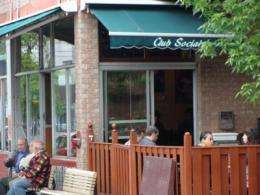Mile End chic under study

A neighbourhood's raw, edgy atmosphere is an essential feature in attracting designers, according to new research from Concordia University and the University of Toronto.
The study focused on Mile End, a multicultural district just north of downtown Montreal, long envied for its staple bagel shops and often depicted as the epicentre of all things Jewish by the late Canadian novelist, Mordecai Richler.
"The Mile End has grown in such a way that people of all walks of life rub shoulders in its third spaces," says first author Norma Rantisi, a professor in Concordia's Department of Geography, Planning and Environment. "Bodies, mass and matter collide there, producing a vibrancy that fosters creativity."
Rantisi's collaborative study, "Materiality and creative production: the case of the Mile End neighbourhood in Montreal," is published in the journal Environment and Planning A. In it, she examines the impact of built environments and third spaces -- public areas that help define an urban landscape -- in producing an atmosphere that draws and nurtures designers.
Dynamic history
The Mile End has a dense, culturally diverse landscape, which comes from a history that includes stints as a streetcar suburb during the City Beautiful Movement, from 1890 to 1910, a movement led by the middle and upper classes to deal with rising issues of sanitation, crime and overpopulation of cities.
The Mile End was also a way station for 19th- and 20th-century European immigrants, and a location for the city's once-thriving garment and textile industry.
Today, the neighbourhood is home to various cultural industries such as the animation firm, Discreet Logic and the computer game developer, Ubisoft. Old greystone buildings, warehouses and factories contain cheap lofts and artists' studios.
"The Mile End's industrial architecture, narrow alleys, ethnic restaurants and cafés serve as magnets for cultural industries and designers," says Rantisi. "Low rents keep them there."
Rantisi and co-author Deborah Leslie interviewed more than 30 fashion and graphic designers who operate in the district. "We focused on the physical attributes that drew them to the area" says Leslie, Canada Research Chair in the Cultural Economy and a professor in the Department of Geography and Planning at the University of Toronto. "We wanted to know why Mile End now hosts so many of them."
Third space conviviality
The authors also interviewed community officials and proprietors of commercial establishments, such as the owner of the Club Social café on St-Viateur Street.
Formerly a private Italian social club for men, the café has emerged as one of the quartier's principal third spaces -- where Italian men and local culture producers cross paths -- and espressos and lattes are sipped at adjacent tables.
That Mile End still has third spaces which appeal to designers is thanks in part to timely heritage legislation from the city of Montreal, which preserved much of its built environment. Another factor was the city's moratorium on conversions of industrial buildings to condominiums from 1975 to 1993.
Cost of gentrification
But not all such intervention is so propitious. Sometimes it leads to gentrification, which has been known to replace creativity with sanitized cosmopolitanism.
"Gentrification, dragging in its wake high rents, expensive renovations, and population displacement, can produce a theme park atmosphere, destroying a neighborhood's character," says Rantisi. "To prevent this, residents must have a strong voice in any plans to fix it up."
Mile Enders clearly agree with Rantisi. They began testing their voice with a Citizen's Committee, which has published proposals that reflect a shared concern for their built environment: More green spaces, a community centre and a public market, all designed to support Mile End's creativity and conviviality.
More information: www.envplan.com/abstract.cgi?id=a4310
Provided by Concordia University
















